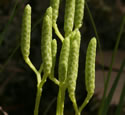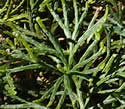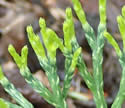Diphasiastrum tristachyum (Blue Groundcedar)
| Also known as: | Wirey Groundcedar, Deep-root Clubmoss |
|---|---|
| Genus: | Diphasiastrum |
| Family: | Lycopodiaceae (Clubmoss) |
| Origin: | native |
| Habitat: | ; dry sandy or rocky soil; coniferous forest, forest edges, fields, rock outcrops |
| Fruiting season: | July - October |
| Plant height: | 4 to 12 inches |
| Wetland Indicator Status: | none |
| MN county distribution (click map to enlarge): |  |
| National distribution (click map to enlarge): |  |
Pick an image for a larger view. See the glossary for icon descriptions.
Detailed Information
Leaves and stems:
![[photo of leaves and branches]](/udata/r9ndp23q/pd3/diphasiastrum-tristachyum-061516-5-t.jpg) Leaves are evergreen, appearing opposite but spirally arranged with 4 evenly spaced leaves in a cycle, appearing as 4 columns when viewed from the side of the stem (4-ranked). Branch leaves are blue-green, appressed with the base extending down the stem (decurrent), the whole leaf narrowly spatula-shaped and broadest near the tip. The free portion is scale-like, up to 1/16 inch (to 1.7 mm) long, to .9 mm wide, toothless, tapering to a pointed tip and is often whitish green at the tip end. All 4 leaves in a spiral cycle are similar in size and shape, making the branches squarish to roundish in cross-section.
Leaves are evergreen, appearing opposite but spirally arranged with 4 evenly spaced leaves in a cycle, appearing as 4 columns when viewed from the side of the stem (4-ranked). Branch leaves are blue-green, appressed with the base extending down the stem (decurrent), the whole leaf narrowly spatula-shaped and broadest near the tip. The free portion is scale-like, up to 1/16 inch (to 1.7 mm) long, to .9 mm wide, toothless, tapering to a pointed tip and is often whitish green at the tip end. All 4 leaves in a spiral cycle are similar in size and shape, making the branches squarish to roundish in cross-section.
![[close-up of annual constriction]](/udata/r9ndp23q/pd3/diphasiastrum-tristachyum-6-15-8-t.jpg) Horizontal stems are underground, buried 2 inches or more. At fairly regular intervals, erect shoots emerge, each with 2 or more branches near the base. Branches are mostly erect to ascending, and forked with the branchlets more or less spreading on the same plane, fan-like. Each year's new growth is marked by a distinct constriction where the annual bud grew. The erect shoots may reach up to 12 inches tall, though vegetative shoots are much shorter.
Horizontal stems are underground, buried 2 inches or more. At fairly regular intervals, erect shoots emerge, each with 2 or more branches near the base. Branches are mostly erect to ascending, and forked with the branchlets more or less spreading on the same plane, fan-like. Each year's new growth is marked by a distinct constriction where the annual bud grew. The erect shoots may reach up to 12 inches tall, though vegetative shoots are much shorter.
Spores:
![[photo of immature strobili]](/udata/r9ndp23q/pd3/diphasiastrum-tristachyum-071316-13-t.jpg) Spores develop in spike-like or cone-like structures called strobili, usually 3 or 4 strobili clustered at the tip of a long stalk (peduncle), occasionally 2 or as many as 7. One to 3 peduncles rise up to 5 inches above the leaves, with appressed, scale-like leaves spiraling up at regular intervals. Strobili are 3/8 to 1+ inch long, each strobilus also distinctly stalked on forked branches, stalks typically becoming shorter with each fork. Each tiny spore sac is attached to a scale (sporophyll) that is about 1/8 inch (to 3.5mm) long, broadly diamond to tear-drop shaped and tapering to a slender, sharply pointed tip. Scales are initially light blue-green and tightly appressed, turning yellowish as they mature and light brown when dry, then become more spreading to release the spores in late summer into fall. The strobili can persist through winter.
Spores develop in spike-like or cone-like structures called strobili, usually 3 or 4 strobili clustered at the tip of a long stalk (peduncle), occasionally 2 or as many as 7. One to 3 peduncles rise up to 5 inches above the leaves, with appressed, scale-like leaves spiraling up at regular intervals. Strobili are 3/8 to 1+ inch long, each strobilus also distinctly stalked on forked branches, stalks typically becoming shorter with each fork. Each tiny spore sac is attached to a scale (sporophyll) that is about 1/8 inch (to 3.5mm) long, broadly diamond to tear-drop shaped and tapering to a slender, sharply pointed tip. Scales are initially light blue-green and tightly appressed, turning yellowish as they mature and light brown when dry, then become more spreading to release the spores in late summer into fall. The strobili can persist through winter.
Notes:
Blue Groundcedar is a circumpolar species and occasional in Minnesota's northern forests, in sandy or rocky soils and usually associated with pines. It is among the species formerly all lumped into Lycopodium (L. tristachyum), which many references have now split into several genera and we have followed suit. Distinguishing characteristics of the new groups are: whether spores develop in cone-like strobili or in leaf (or leaf-like) axils, whether strobili are stalked or stalkless, whether horizontal stems are above or below ground, whether branching on erect shoots is tree-like or not, the number of leaves in a spiral cycle, whether leaves are scale-like or not and whether they have a hair-like tip. The Diphasiastrum species all have stalked strobili, tree-like branching, leaves that are scale-like, 4-ranked and lack a hair-like tip. The tree-like branching and scale-like leaves resemble little cedar trees and is why they are commonly called groundcedars. Blue Groundcedar also has underground horizontal stems, strobili usually clustered 3 or 4 on forked branches at the tip of the stalk, leaves that are blue-green and all 4 in a spiral cycle similar in size and shape that make the branches squarish in cross-section. The leaf color and sizes combined with branch shape can help identify it even when strobili are not present.
Of the other Diphasiastrum species in Minnesota, Northern Groundcedar (D. complanatum) and Southern Groundcedar (D. digitatum), both have horizontal stems above ground or just below the surface of the duff layer, are green rather than blue-green and have branches that appear much broader, rectangular in cross-section, the underside distinctly flattened with the associated leaf much smaller than the others. Compare with other clubmosses with cone-like strobili: Spinulum species have stalkless strobili and lack tree-like branching, Lycopodium have stalked strobili but lack tree-like branching, and Dendrolycopodium have tree-like branching but stalkless strobili single at branch tips, and none of these have scale-like leaves. D. tristachyum hybridizes with both of Minnesota's other groundcedars, the hybrid with D. complanatum (D. ×zeilleri) most common and with D. digitatum (D. ×habereri) less so. Descriptive information on the hybrids is not well documented but intermediate characteristics are likely.
Native Plant Nurseries, Restoration and Landscaping Services ↓
More photos
 Blue Groundcedar plant
Blue Groundcedar plant Blue Groundcedar plant
Blue Groundcedar plant Blue Groundcedar plants
Blue Groundcedar plants Blue Groundcedar plants
Blue Groundcedar plants Blue Groundcedar habitat
Blue Groundcedar habitat vegetative shoots
vegetative shoots new growth in mid June
new growth in mid June
Photos by K. Chayka taken in Cook County. Photos courtesy Peter M. Dziuk taken in Cook County.
Comments
Have you seen this plant in Minnesota, or have any other comments about it?






